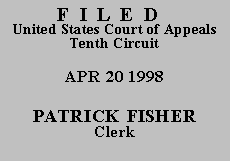

| HEARTSPRINGS, INC., |
No. 97-3011 |
William Bruce Day (David B. Pointer and Judith L. Kloster with him on the briefs), Stinson, Mag & Fizzell, P.C., Kansas City, Missouri, for Defendant - Appellee.
The Parties
We begin with a brief description of the parties and the events leading to the current action.(2) Plaintiff Heartsprings is a for-profit Arizona corporation created in March 1991. Plaintiff's products consist primarily of printed materials, such as books, pamphlets, and comic books, designed to help children acquire better relationships in life, school, and the community. Plaintiff actively markets these products under the prominent titles of "PATHWAYS TO RESILIENCY," "STORY WORKBOOK," and "PEACEBUILDERS." See, e.g., Figure 1.
Each of plaintiff's titled publications discusses a specific topic (e.g., "I bring peace to Tucson."). These individual topics are organized under separate "segments" (e.g., "Social Competence"), and the segments are further organized into separate titled programs (e.g., "STORY WORKBOOK"). Plaintiff generally seeks sponsors to support each topic publication it produces and will print a sponsor's corporate logo on the cover of the supported publication in exchange for the sponsor's contribution. See, e.g., Figure 1. Past sponsors include Pizza Hut, Delta Airlines, The Arizona Daily Star, and Desert Hills Center for Youth & Families.
Defendant Heartspring is a private, non-profit organization based in Wichita, Kansas. Defendant operates a residential school solely for physically disabled children. Prospective students submit to an extensive diagnostic screening process, and children suffering from psychological ailments are referred elsewhere. The cost of defendant's services ranges from $90,000 to $150,000 per year. Defendant Heartspring also runs a number of outpatient programs, which diagnose disabled children, provide referrals, and provide parents with information about their childs educational rights.
Defendant originally operated under the name "Institute of Logopedics." In Spring 1992, however, defendant decided the word "logopedics" was unclear to the public and the word "institute" had unpleasant connotations which "did not reflect [defendants] focus of helping children gain independence and better integrate into their communities." In search of a name to invoke "more positive feelings towards children," defendant recruited an advertising agency to compile a list of 50 to 60 prospective names. Defendant submitted the list to its Board of Trustees, and each board member voted on the names he or she liked best, generating a short list, which was in turn submitted to a series of focus groups. Using information obtained from the focus groups, defendant tentatively selected the name "Heartspring." At defendant's request, an intellectual property attorney conducted a trademark search. Because plaintiff had not registered its own trade name, however, the search did not reveal plaintiff's use of the name "Heartsprings." Defendant subsequently changed its corporate name to "Heartspring" and spent nearly $200,000 promoting its new identity. Defendant attempted to register the name as a service trademark for a "non-profit school for disabled children," but plaintiff Heartsprings filed a notice of opposition, spawning the current suit.
Applicable Law
The district court granted summary judgment for defendant Heartspring on the ground no likelihood of confusion exists. We must affirm the district court's order if the record reveals no genuine dispute of material fact and defendant Heartspring is entitled to judgment as a matter of law. Fed. R. Civ. P. 56(c) ("The judgment sought shall be rendered [if the record shows] that there is no genuine issue as to any material fact and that the moving party is entitled to a judgment as a matter of law."). A genuine issue of material fact exists if a reasonable fact finder could return a verdict for the non-moving party. Anderson v. Liberty Lobby, Inc., 477 U.S. 242, 248 (1986). Plaintiff Heartsprings contends a genuine dispute of material fact remains on the issue of likelihood of confusion.
Likelihood of confusion is a question of fact we review for clear error. Cardtoons, L.C. v. Major League Baseball Players Ass'n, 95 F.3d 959, 967 (10th Cir. 1996); see also Beer Nuts, Inc. v. Clover Club Foods Co., 805 F.2d 920, 923 n.2 (10th Cir. 1986) (discussing the circuit split regarding appropriate standard of review for likelihood of confusion and reaffirming Tenth Circuit's general rule of treating the issue as a question of fact subject to review for clear error). In this case, the district court found consumers were unlikely to confuse the two marks at issue. If this finding is not clearly erroneous, the plaintiff's claim fails. Two Pesos, Inc. v. Taco Cabana, Inc., 505 U.S. 763, 769 (1992) ("[L]iability under § 43(a) requires proof of the likelihood of confusion."); Jordache Enterprises v. Hogg Wyld, Ltd., 828 F.2d 1482, 1484 (10th Cir. 1987) ("'Confusion occurs when consumers make an incorrect mental association between the involved commercial products or their producers.'" (quoting with approval San Francisco Arts & Athletics, Inc. v. United States Olympic Comm., 483 U.S. 522, 564 (1987) (Brennan, J., dissenting))).
This court considers the following factors relevant to a determination whether a likelihood of confusion exists:
(a) the degree of similarity between the marks, including the marks appearance, pronunciation, suggestion, and manner of display;
(b) strength or weakness of the plaintiffs mark;
(c) the intent of the alleged infringer in adopting its mark;
(d) similarities and differences of the parties' goods, services and marketing strategies;
(e) the degree of care likely to be exercised by purchasers of the goods or services involved; and
(f) evidence of actual confusion, if any.
See, e.g., Universal Money Ctrs., Inc. v. American Tel. & Tel. Co., 22 F.3d 1527, 1530 (10th Cir. 1994) (discussing factors). Some of these factors may prove more relevant than others, depending on the facts of each case; moreover, other cases may demand consideration of factors not mentioned here. Jordache, 828 F.2d at 1484. No one factor is dispositive, and the final determination of likelihood of confusion must be based on consideration of all relevant factors. Beer Nuts, 805 F.2d at 925. In every case, however, the key inquiry is whether the consumer is "likely to be deceived or confused by the similarity of the marks." Two Pesos, 505 U.S. at 780. We turn now to the district court's treatment of the relevant factors.
The Marks' Degree of Similarity
In evaluating the degree of similarity between marks, we consider the marks as they are encountered by the consumer in the marketplace and examine them on three levels: sight, sound, and meaning. First Sav. Bank v. First Bank Sys., Inc., 101 F.3d 645, 653 (10th Cir. 1996). Each mark must be considered as a whole. Universal, 22 F.3d at 1531. Even if the trade names are similar, the likelihood of confusion is reduced if the two trademarks, taken as a whole, are visually distinct. Id.; First Sav. Bank, 101 F.3d at 653.
The district court concluded this factor favored plaintiff because of the virtual identity of trade names, but only slightly. Taking into account the visual differences of the parties' respective trade names, the court concluded "[t]his factor does not weigh in plaintiff's favor as much as would first appear."
Plaintiff Heartsprings argues the district court's analysis is an improper "'side-by-side'" comparison of the marks. Universal, 22 F.3d at 1531 ("In evaluating similarity, we must not engage in a 'side-by-side' comparison. Rather, the court must determine whether the alleged infringing mark will be confusing to the public when singly presented."(citations omitted)). Plaintiff contends the virtual identity of the two names, which differ only by a single "s," mandates a finding strongly in favor of plaintiff on this factor.
We find plaintiff's argument unpersuasive. First, Universal does not prohibit comparison of the parties' marks; it prohibits consideration of differences so minuscule they are only detectable via a side-by-side comparison. See, e.g., Universal, 22 F.3d at 1531 (comparing the visual presentations of the two marks at issue); Beer Nuts, 805 F.2d at 926 ("The presence of the smaller [defendant's] trademark is not enough to eliminate the likelihood of confusion in this case where the products and their marks are similar because consumers typically do not engage in side by side comparison of [inexpensive] products."). Second, because we must consider the parties' trademarks in their entirety as they are experienced by consumers in the marketplace, we are not free to focus solely on name similarity. Plaintiff's proffered analysis therefore runs against precedent.
The district court's conclusion on this factor is amply supported by the record. Plaintiff uses the trade name "Heartsprings, Inc." primarily for identification, not marketing, purposes. The trade name normally appears only on the inside of plaintiff's publications or is printed in a small, regular font at the bottom of its advertising materials in connection with copyright notices and mailing addresses. See Figures 2, 4. Instead of actively marketing its products under the name "Heartsprings," plaintiff publishes its materials under prominent titles that do not include or refer to its mark. See Figures 1, 3. In contrast, defendant's trade name "Heartspring" is consistently presented in stylized block lettering with a purple and teal heart logo, and this design is prominently displayed throughout defendant's correspondence and promotional materials. See Figures 5, 6. As this record shows, plaintiff's and defendant's use and presentation of their respective trade names bear no similarity beyond the obvious sameness of spelling and clearly support the district court's conclusion the marks at issue in this case "are somewhat visually distinct." See Figures 1-6. Accordingly, the district court did not err by declining to weigh this factor firmly in plaintiff's favor.
Strength or Weakness of Plaintiffs Mark
To determine the relative strength of plaintiff's trademark, we place the mark in one of five categories of increasing distinctiveness and strength: (1) generic; (2) descriptive; (3) suggestive; (4) arbitrary; or (5) fanciful. Two Pesos, 505 U.S. at 768. We have defined these terms as follows:
A generic term is a term used to describe the relevant type or class of goods. It is the weakest mark and cannot become a trademark under any circumstances. A descriptive term describes a characteristic of a product or service . . . . The third, and stronger, mark is the suggestive mark, which suggests rather than describes a characteristic of the product and requires the consumer to use imagination and perception to determine the product's nature. Finally, the arbitrary or fanciful mark is the strongest mark. An arbitrary mark has a common meaning unrelated to the product for which it has been assigned, such as APPLE when applied to computers, while a fanciful mark, such as KODAK or EXXON, signifies nothing but the product.
First Sav. Bank, 101 F.3d at 654-55 (citations omitted). The district court found plaintiff Heartsprings' mark to be "suggestive and relatively strong," and therefore weighed this factor in plaintiff's favor.
Plaintiff Heartsprings argues the district court improperly characterized "Heartsprings" as merely suggestive and contends the mark is arbitrary and therefore "entitled to the strongest form of protection." "While HEARTSPRINGS fosters a particular connotation," plaintiff reasons, "it in no way suggests Plaintiff's educational services. Thus, this factor weighs even more strongly in Plaintiff's favor than indicated by the District Court."
We agree with the district court's conclusion plaintiff's mark is suggestive, not arbitrary. To qualify as arbitrary, a mark must have "a common meaning unrelated to the product for which it has been assigned, such as APPLE when applied to computers." First Sav. Bank, 101 F.3d at 655. "Heartsprings" does not have a common meaning and therefore cannot be considered arbitrary. The word, however, is highly suggestive. Plaintiff admits it selected the name "to convey emotional characteristics of family and child life rather than problems, that would be aimed at 'wellness' rather than problems, and that would suggest 'springing forth' and be 'pro-active.'" The connotations for which plaintiff chose its name clearly "suggest[] rather than describe[] a characteristic of the [plaintiff's] product and require[] the consumer to use imagination and perception to determine the product's nature." Id. at 654. We therefore find no error in the district court's classification of plaintiff's mark as suggestive.
The Intent of the Alleged Infringer in Adopting its Mark
If an alleged infringer adopted its mark for the purpose of deriving benefit from a plaintiff's existing mark, this intent weighs firmly in the plaintiff's favor. Universal, 22 F.3d at 1532 ("The proper focus [remains] whether defendant had the intent to derive benefit from the reputation or goodwill of plaintiff."). Conversely, if the evidence indicates a defendant did not intend to derive benefit from a plaintiff's existing mark, this factor weighs against the likelihood of confusion. First Sav. Bank, 101 F.3d at 655. The district court found "there is no evidence that defendant intended to take advantage of plaintiff's having a similar name" and concluded "defendant is relying on its own goodwill and reputation, and not that of plaintiff." Accordingly, the district court weighed this factor in defendant Heartspring's favor. Plaintiff Heartsprings raises no specific objection to this finding and we find no error. Even in the light most favorable to plaintiff, the evidence shows defendant Heartspring took care in selecting and checking its new name. The district court's conclusion is therefore well-supported by the record.
Marketing Similarities and Differences
The marketing practices of the parties are particularly relevant in a trademark infringement case because these practices directly impact the way in which consumers experience the parties' respective marks. "The greater the similarity between the products and services, the greater the likelihood of confusion." Universal, 22 F.3d at 1532. Similarly, the greater the degree of overlap in the marketing approaches of the two entities, the greater the likelihood of confusion. Id.
The record shows plaintiff Heartsprings actively markets its products to school districts, government agencies, and military personnel. The plaintiff participates in seminars and conventions geared toward violence prevention, such as meetings of the National Association of Prevention professionals. Although plaintiff prepares and sells educational materials for use by schools, military bases, and parents, it does not run a school of its own. The plaintiff's products take the form of educational stories which illustrate methods of avoiding violent confrontations or effecting conflict resolution without resort to violence. Although plaintiff seeks sponsors to support its publications, its Sponsorship Agreements resemble advertising and promotional agreements more than charitable contributions.
Defendant Heartsprings primary business is the operation of a single residential school for physically disabled children. The school focuses on teaching these children basic life skills, "such as the ability to cross a street, walk down a sidewalk, cook, dress themselves, go to the grocery store or ride a bus." The defendant focuses its marketing efforts on "people who contact children with disabilities." It advertises at annual conventions attended by persons who deal with disabled children, like the National Society for Autism. The defendant advertises in Exceptional Parent Magazine and sends direct mailings to the magazines subscribers. Defendant Heartspring also targets educational consultants who provide parents of disabled children with guidance in finding appropriate educational programs. Defendant actively solicits charitable donations from private parties, foundations, and civic associations and groups.
On this record, the district court found "[t]he differences between the parties' products far outweigh the similarities . . . and militate against a finding of likelihood of confusion." Defendant Heartspring, the court reasoned, markets basic skills training to a specialized population, the physically handicapped, whereas plaintiff Heartsprings markets publications devoted to nonviolent training for use with the general child population. "Thus," the court concluded, "the parties are not competitors and do not provide products for the same groups of consumers."
Plaintiff Heartsprings contends the district court has made "subtle distinctions" between the parties' marketing practices which are inappropriate at the summary judgment stage. This argument is unpersuasive. Although we are required to view the evidence in the light most favorable to the nonmoving party, we must not refrain from examining the evidence altogether. The record shows plaintiff and defendant operate in distinctly different markets, sell distinctly different products, and contact, for the most part, very different people in their marketing efforts.(3) Consequently, the district court did not clearly err by taking note of these product and marketing differences and weighing this factor in favor of defendant.
Consumer's Degree of Care
A consumer exercising a high degree of care in selecting a product reduces the likelihood of confusing similar trade names. Universal, 22 F.3d at 1533. The district court found consumers exercise a high degree of care in selecting defendant Heartspring's services. The cost of defendant's residential school is substantial, and defendant admits only students with severe physical disabilities. Consumers of those services must be willing to entrust their physically disabled children to defendant's care and supervision at a significant cost. Based on these facts, the district court concluded "the high degree of care needed by consumers purchasing the [defendant's] goods and services . . . makes confusion between the parties' marks and names unlikely." The district court therefore weighed this factor in defendant's favor. We find no clear error in this analysis.
Evidence of Actual Confusion, if Any
Although not necessary to a § 43(a) claim, evidence of actual confusion within the marketplace is strong evidence of a likelihood of confusion. Universal, 22 F.3d at 1534. To be relevant, however, such evidence should demonstrate actual confusion among consumers within the marketplace. Coherent, Inc. v. Coherent Tech., Inc., 935 F.2d 1122, 1126 (10th Cir. 1991). In its brief, plaintiff offers the following incidents as evidence of actual confusion:
Heartsprings Founder, Dr. Embry, testified that after he appeared before two Kansas Legislative Committees, someone asked whether he was connected with Heartspring in Wichita. Likewise, after a meeting with an aide to Senator Dole in Washington, the aide asked how Dr. Embry was involved with Heartspring in Wichita. After an article about a [Society for the Preservation and Encouragement of Barber Shop Quartet Singing in America] local fund raiser mentioned Defendant as the [Society's] national charity, Dr. Embrys travel agent and his accountant both called and professed ignorance of Plaintiffs having a fund raiser. Finally, Michael Krupnick, Plaintiffs President, testified that a friend had seen the article and asked what Plaintiff was doing in Kansas.
The district court found this evidence to be of "little weight" because the evidence is anecdotal and indicates only "isolated instances of possible confusion." Jordache, 828 F.2d at 1487 ("[W]hile customer enquiry evidence is admissible and relevant, standing alone with no other evidence it is insufficient proof of actual confusion."). Further, the court noted, the plaintiff's proffered evidence does not indicate confusion among consumers, only random acquaintances, and therefore is de minimis. Universal, 22 F.3d at 1535 (isolated instances of actual confusion are de minimis and insufficient to establish a genuine issue of material fact). Accordingly, the district court weighed this factor in defendant's favor. We find no error in this analysis.
All Relevant Factors Considered as a Whole
As we emphasized before, all relevant factors must be weighed to determine the likelihood of confusion. See Beer Nuts, 805 F.2d at 925. Because no single factor is dispositive, even if the district court incorrectly analyzes one or more factors, a genuine dispute of material fact will not exist if all relevant factors, properly analyzed and considered together, nonetheless indicate consumers are not likely to be confused. See, e.g., Universal, 22 F.3d at 1527 (although the appropriate standard of review compelled the appellate court to assume the existence of actual confusion, all factors, when considered together, nonetheless failed to indicate a likelihood of confusion).
The district court noted that the virtual identity between the parties' trade names and the strength of plaintiff's suggestive name would indicate a likelihood of confusion. In the court's view, however, these two factors are insufficient to indicate a likelihood of confusion when the other relevant factors are considered. Accordingly, the court held "no reasonable fact-finder could conclude that a likelihood of confusion exists, and summary judgment is therefore appropriate for the defendant."
This conclusion is well supported by the record. As the district court found, plaintiff Heartsprings' name is not prominently presented to the public and is not presented in a uniform stylized logo, as is defendant Heartspring's name. The evidence clearly indicates defendant Heartspring did not choose its name based on a desire to associate itself with plaintiff's mark or benefit from plaintiff's goodwill or reputation. The parties offer distinctly different products and services and conduct different marketing campaigns, aimed at different portions of the public. The high degree of care consumers are likely to exercise in selecting defendant's unique and expensive services further reduces the possibility of consumer confusion between plaintiff's and defendant's marks. Furthermore, there is no evidence of actual confusion within the consuming public. Beyond the virtual identity between the parties' names and the fact the parties conduct business within the very broad category of products for children, there is little overlap between the parties' products, services or marketing strategies. On this record, we cannot find clear error in the district court's failure to find a likelihood of confusion; indeed, we have affirmed a similar conclusion based on an analogous, but more compelling, record. See Coherent, 935 F.2d at 1125 (both parties manufactured related laser products, both parties sold their products to the U.S. government, and both parties were listed in the Laser Focus Buyers' Guide). Summary judgment for defendant Heartspring is therefore appropriate, and the district court judgment is AFFIRMED.
Table of Figures
Figure 1. Front cover, plaintiff Heartsprings' publication, "Pathways to Resiliency: I help build peace in _____."
Figure 2. Inside cover, plaintiff Heartsprings' publication, "Pathways to Resiliency: I help build peace in _____."
Figure 3. Front cover, plaintiff Heartsprings' publication, "PeaceBuilders: Action Guide."
Figure 4. Inside cover, plaintiff Heartsprings' publication, "PeaceBuilders: Action Guide."
Figure 5. Defendant Heartspring's advertisement from Exceptional Parent, March 1993 at 87.
Figure 6. One of defendant Heartspring's promotional brochures.
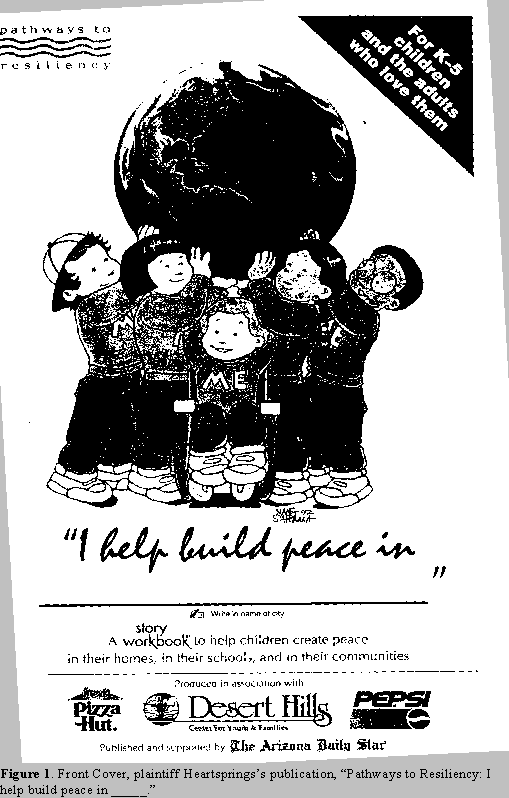
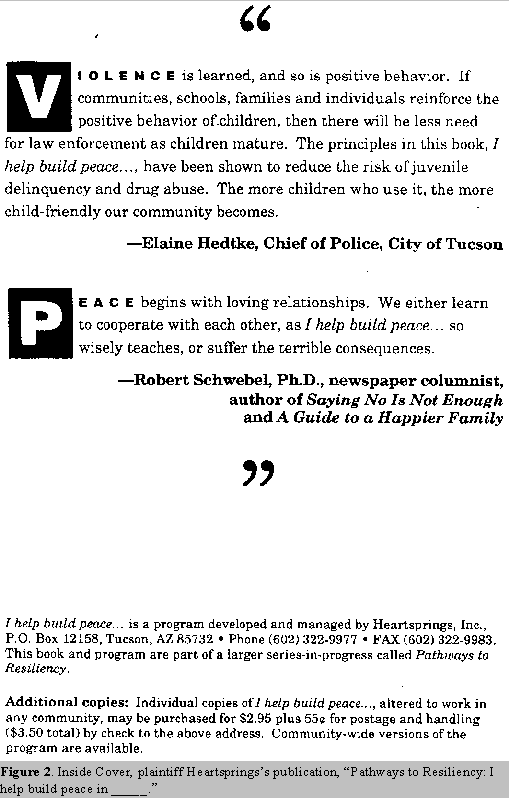
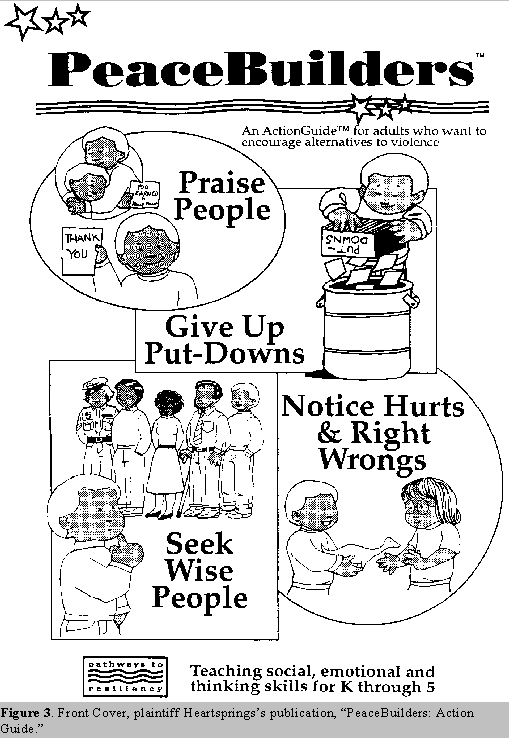
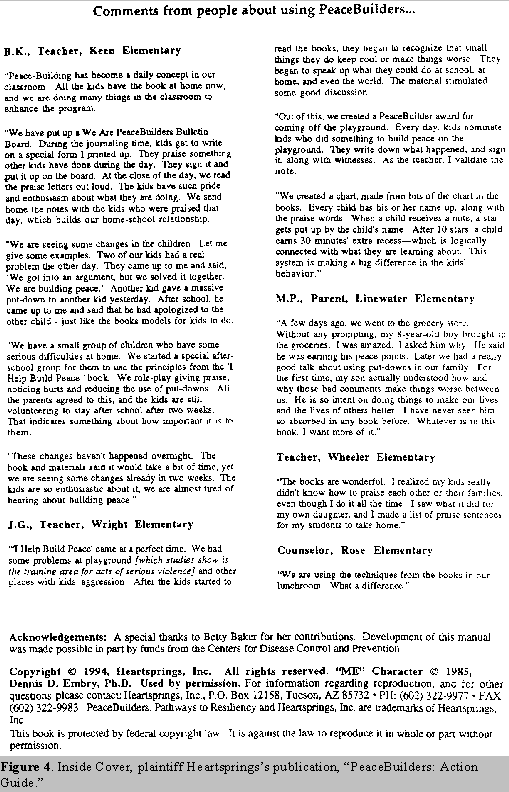
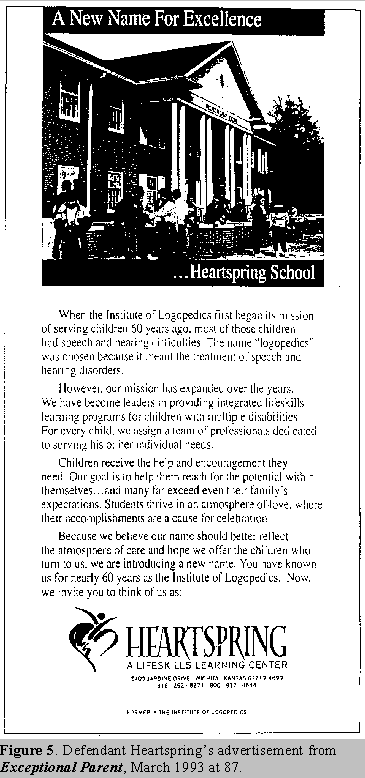
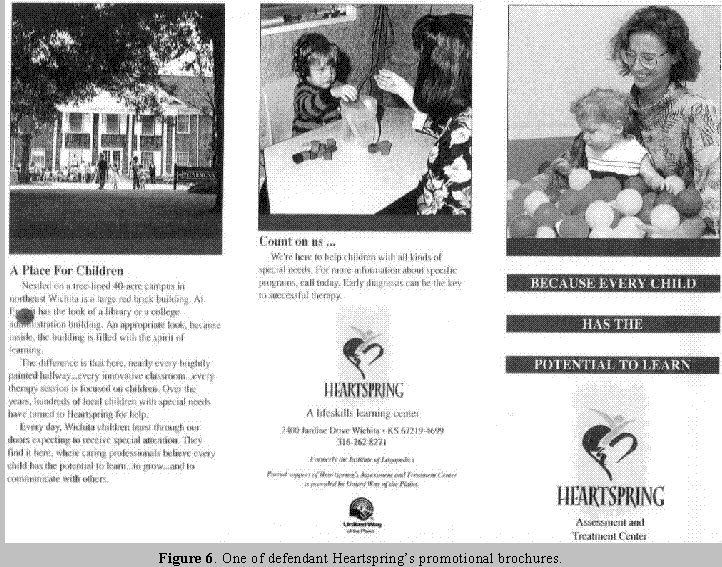
*.The Honorable Thomas R. Brett, District Judge, United States District Court for the Northern District of Oklahoma, sitting by designation.
1.Section 43(a) of the Lanham Act reads in its relevant part:
Any person who, on or in connection with any goods or services, or any container for goods, uses in commerce any word, term, name, symbol, or device, or any combination thereof, or any false designation of origin, false or misleading description of fact, or false or misleading representation of fact, which -- (A) is likely to cause confusion, or to cause mistake, or to deceive as to the affiliation, connection, or association of such person with another person, or as to the origin, sponsorship, or approval of his or her goods, services, or commercial activities by another person . . . shall be liable in a civil action by any person who believes that he or she is or is likely to be damaged by such act.
15 U.S.C. § 1125(a).
2.With the sole exception of likelihood of confusion, the parties do not dispute the facts in this case. We therefore draw the facts which follow, and the underlying facts used to determine likelihood of confusion, from the record.
3.Plaintiff contends, even if the end users of the parties' services are different, the parties solicit donations and/or sponsorships from the same charitable market, indicating a likelihood of confusion. As its sole evidence of overlap within the donor market, plaintiff cites both parties' efforts to obtain funding from the same Wichita-based family. This single incident, however, is analogous to anecdotal evidence of actual confusion, which, standing alone, is de minimis and does not indicate likelihood of confusion. Universal Money Ctrs., Inc. v. American Tel. & Tel. Co., 22 F.3d 1527, 1535. At any rate, the record demonstrates, even within the donor market, the parties operate in relatively different spheres. The plaintiff tends to seek sponsorships from for-profit corporate entities (e.g., Pizza Hut), and defendant tends to seek donations from non-profit charitable institutions (e.g., the Society for the Preservation and Encouragement of Barber Shop Quartet Singing in America). Thus, the likelihood of confusion, even within the donor market is slim.